load capacity FORD F-53 2020 Owners Manual
[x] Cancel search | Manufacturer: FORD, Model Year: 2020, Model line: F-53, Model: FORD F-53 2020Pages: 197, PDF Size: 3.04 MB
Page 79 of 197
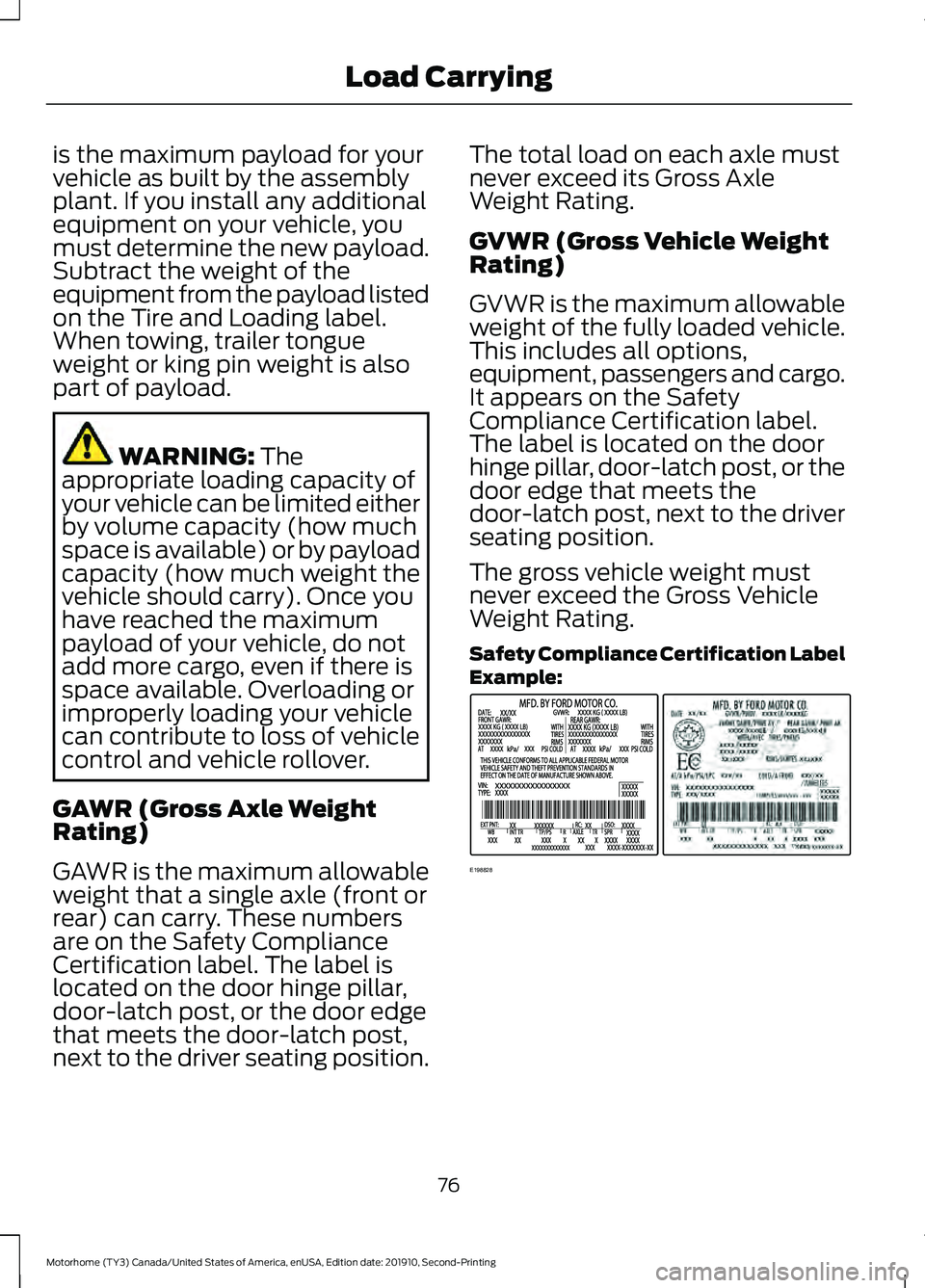
is the maximum payload for your
vehicle as built by the assembly
plant. If you install any additional
equipment on your vehicle, you
must determine the new payload.
Subtract the weight of the
equipment from the payload listed
on the Tire and Loading label.
When towing, trailer tongue
weight or king pin weight is also
part of payload.
WARNING: The
appropriate loading capacity of
your vehicle can be limited either
by volume capacity (how much
space is available) or by payload
capacity (how much weight the
vehicle should carry). Once you
have reached the maximum
payload of your vehicle, do not
add more cargo, even if there is
space available. Overloading or
improperly loading your vehicle
can contribute to loss of vehicle
control and vehicle rollover.
GAWR (Gross Axle Weight
Rating)
GAWR is the maximum allowable
weight that a single axle (front or
rear) can carry. These numbers
are on the Safety Compliance
Certification label. The label is
located on the door hinge pillar,
door-latch post, or the door edge
that meets the door-latch post,
next to the driver seating position. The total load on each axle must
never exceed its Gross Axle
Weight Rating.
GVWR (Gross Vehicle Weight
Rating)
GVWR is the maximum allowable
weight of the fully loaded vehicle.
This includes all options,
equipment, passengers and cargo.
It appears on the Safety
Compliance Certification label.
The label is located on the door
hinge pillar, door-latch post, or the
door edge that meets the
door-latch post, next to the driver
seating position.
The gross vehicle weight must
never exceed the Gross Vehicle
Weight Rating.
Safety Compliance Certification Label
Example:
76
Motorhome (TY3) Canada/United States of America, enUSA, Edition date: 201910, Second-Printing Load CarryingE198828
Page 81 of 197
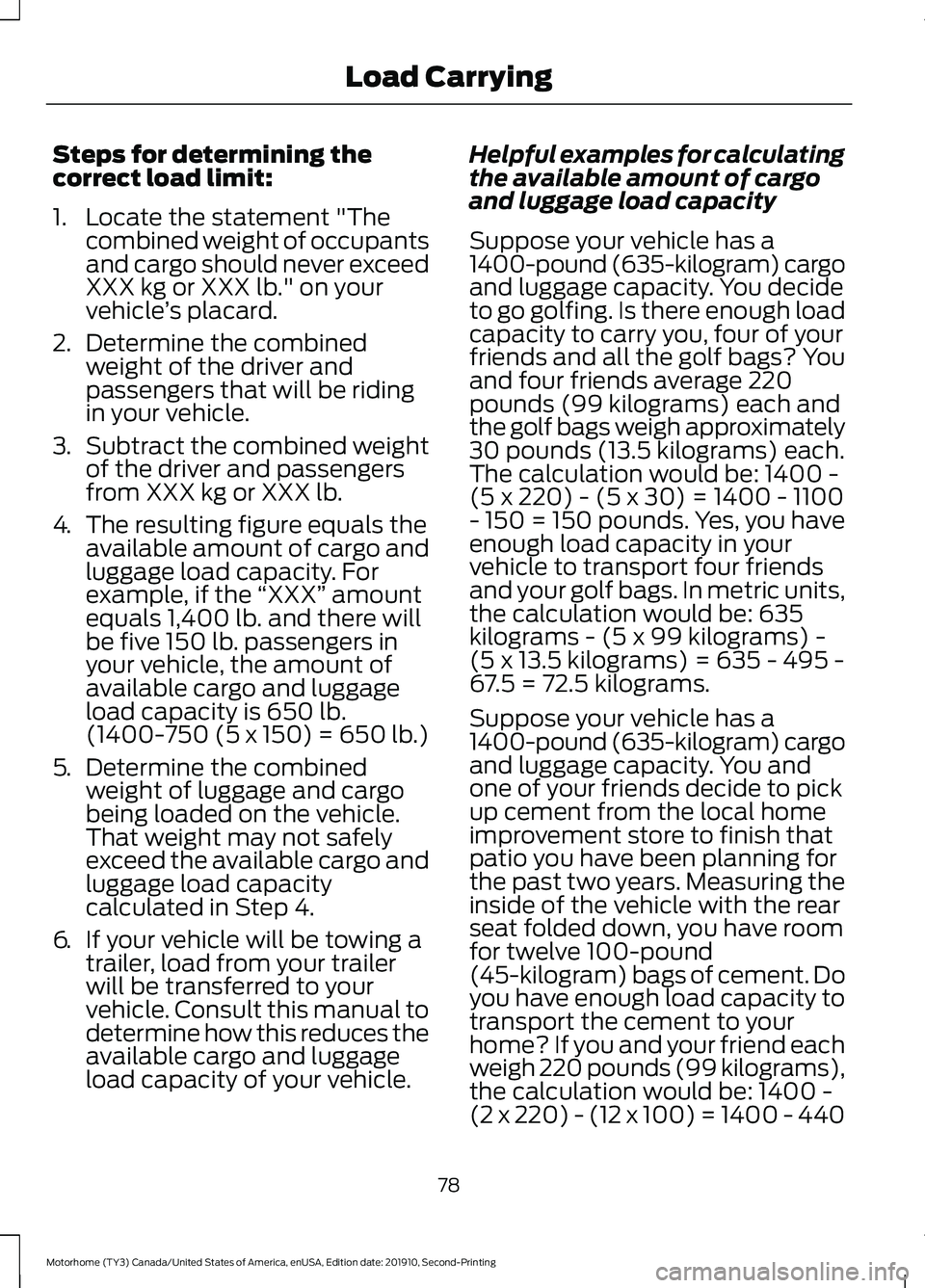
Steps for determining the
correct load limit:
1. Locate the statement "The
combined weight of occupants
and cargo should never exceed
XXX kg or XXX lb." on your
vehicle ’s placard.
2. Determine the combined
weight of the driver and
passengers that will be riding
in your vehicle.
3. Subtract the combined weight
of the driver and passengers
from XXX kg or XXX lb.
4. The resulting figure equals the
available amount of cargo and
luggage load capacity. For
example, if the “XXX” amount
equals 1,400 lb. and there will
be five 150 lb. passengers in
your vehicle, the amount of
available cargo and luggage
load capacity is 650 lb.
(1400-750 (5 x 150) = 650 lb.)
5. Determine the combined
weight of luggage and cargo
being loaded on the vehicle.
That weight may not safely
exceed the available cargo and
luggage load capacity
calculated in Step 4.
6. If your vehicle will be towing a
trailer, load from your trailer
will be transferred to your
vehicle. Consult this manual to
determine how this reduces the
available cargo and luggage
load capacity of your vehicle. Helpful examples for calculating
the available amount of cargo
and luggage load capacity
Suppose your vehicle has a
1400-pound (635-kilogram) cargo
and luggage capacity. You decide
to go golfing. Is there enough load
capacity to carry you, four of your
friends and all the golf bags? You
and four friends average 220
pounds (99 kilograms) each and
the golf bags weigh approximately
30 pounds (13.5 kilograms) each.
The calculation would be: 1400 -
(5 x 220) - (5 x 30) = 1400 - 1100
- 150 = 150 pounds. Yes, you have
enough load capacity in your
vehicle to transport four friends
and your golf bags. In metric units,
the calculation would be: 635
kilograms - (5 x 99 kilograms) -
(5 x 13.5 kilograms) = 635 - 495 -
67.5 = 72.5 kilograms.
Suppose your vehicle has a
1400-pound (635-kilogram) cargo
and luggage capacity. You and
one of your friends decide to pick
up cement from the local home
improvement store to finish that
patio you have been planning for
the past two years. Measuring the
inside of the vehicle with the rear
seat folded down, you have room
for twelve 100-pound
(45-kilogram) bags of cement. Do
you have enough load capacity to
transport the cement to your
home? If you and your friend each
weigh 220 pounds (99 kilograms),
the calculation would be: 1400 -
(2 x 220) - (12 x 100) = 1400 - 440
78
Motorhome (TY3) Canada/United States of America, enUSA, Edition date: 201910, Second-Printing Load Carrying
Page 82 of 197
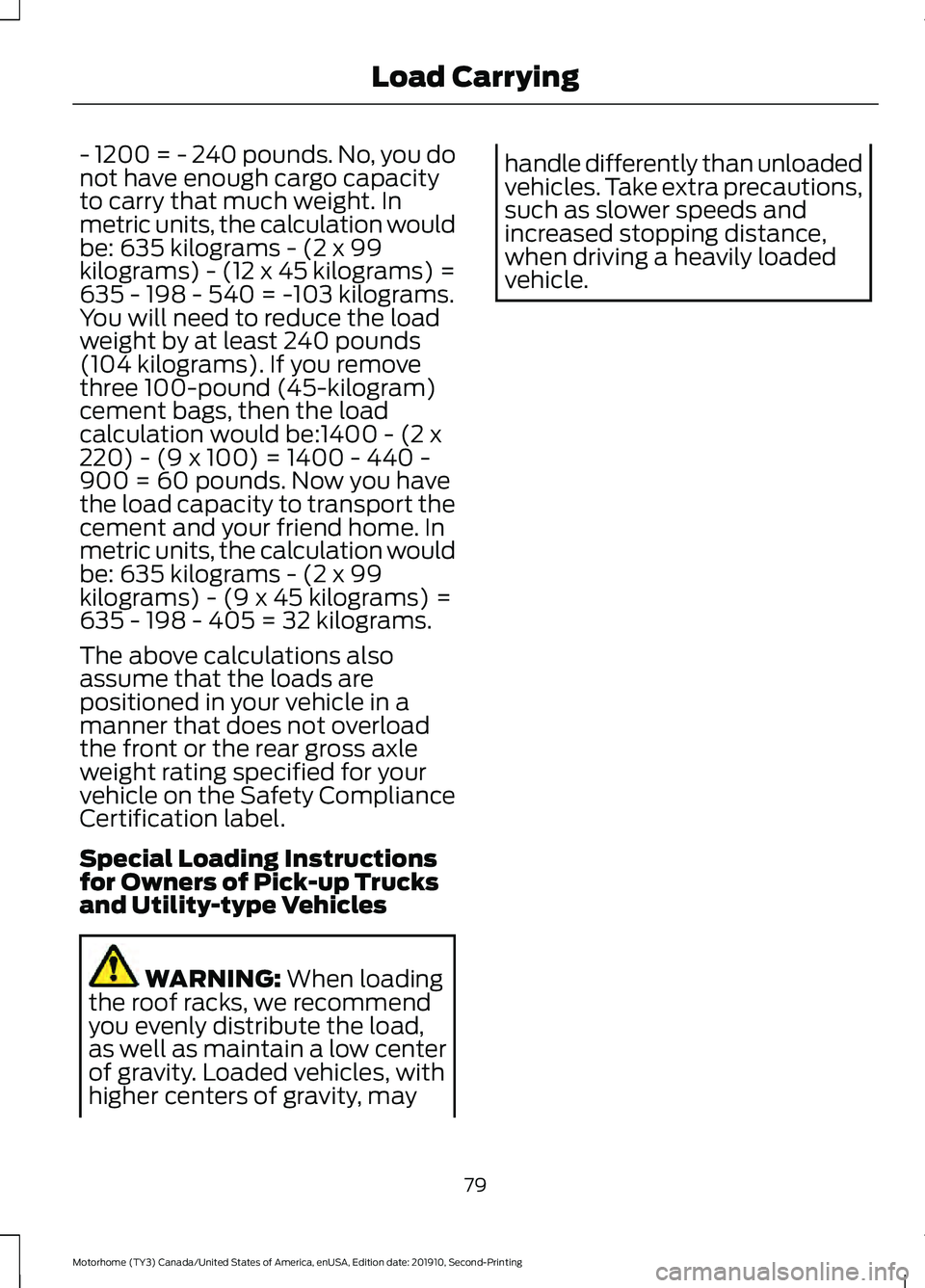
- 1200 = - 240 pounds. No, you do
not have enough cargo capacity
to carry that much weight. In
metric units, the calculation would
be: 635 kilograms - (2 x 99
kilograms) - (12 x 45 kilograms) =
635 - 198 - 540 = -103 kilograms.
You will need to reduce the load
weight by at least 240 pounds
(104 kilograms). If you remove
three 100-pound (45-kilogram)
cement bags, then the load
calculation would be:1400 - (2 x
220) - (9 x 100) = 1400 - 440 -
900 = 60 pounds. Now you have
the load capacity to transport the
cement and your friend home. In
metric units, the calculation would
be: 635 kilograms - (2 x 99
kilograms) - (9 x 45 kilograms) =
635 - 198 - 405 = 32 kilograms.
The above calculations also
assume that the loads are
positioned in your vehicle in a
manner that does not overload
the front or the rear gross axle
weight rating specified for your
vehicle on the Safety Compliance
Certification label.
Special Loading Instructions
for Owners of Pick-up Trucks
and Utility-type Vehicles
WARNING: When loading
the roof racks, we recommend
you evenly distribute the load,
as well as maintain a low center
of gravity. Loaded vehicles, with
higher centers of gravity, may handle differently than unloaded
vehicles. Take extra precautions,
such as slower speeds and
increased stopping distance,
when driving a heavily loaded
vehicle.
79
Motorhome (TY3) Canada/United States of America, enUSA, Edition date: 201910, Second-Printing Load Carrying
Page 83 of 197
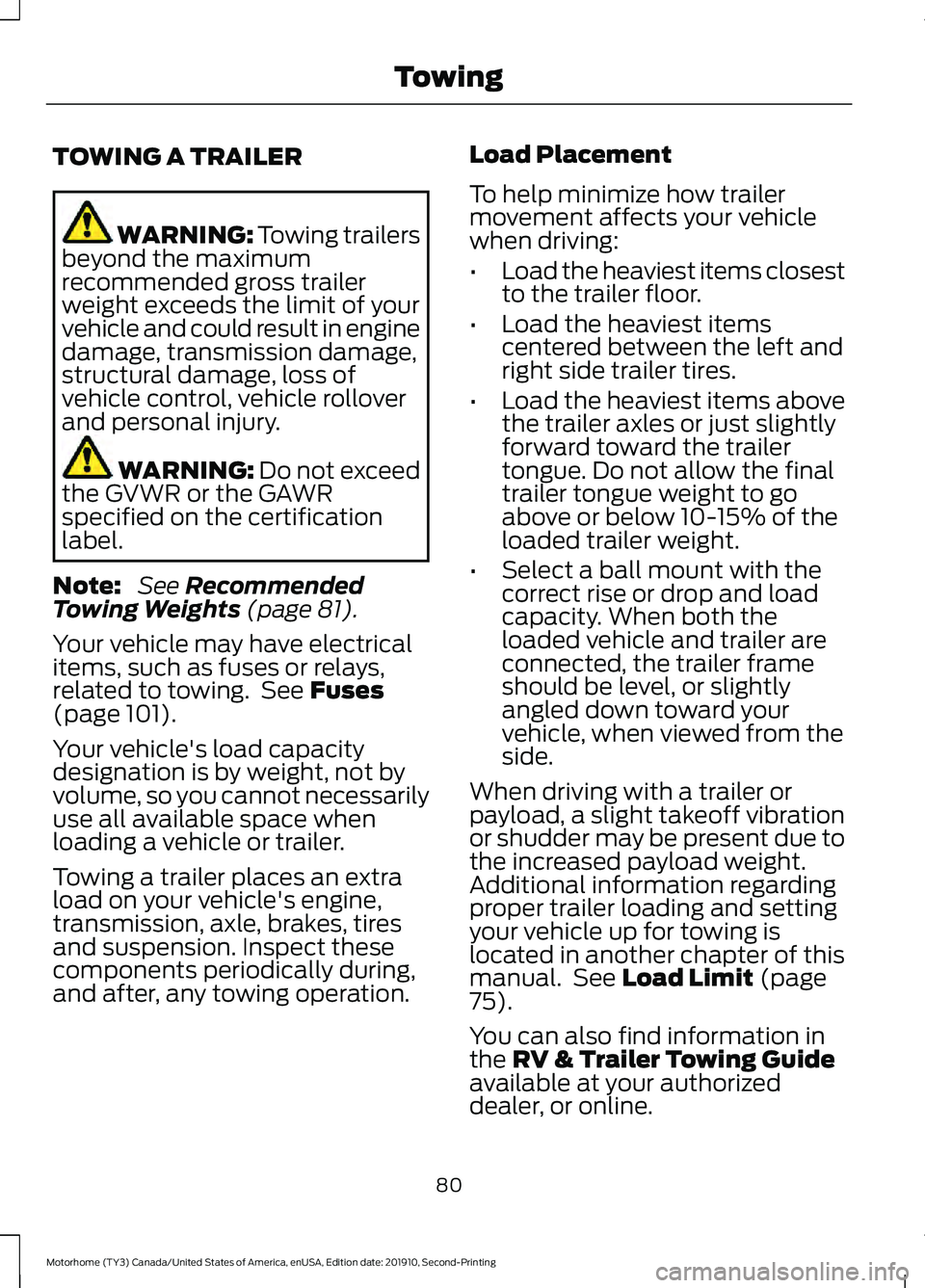
TOWING A TRAILER
WARNING: Towing trailers
beyond the maximum
recommended gross trailer
weight exceeds the limit of your
vehicle and could result in engine
damage, transmission damage,
structural damage, loss of
vehicle control, vehicle rollover
and personal injury. WARNING:
Do not exceed
the GVWR or the GAWR
specified on the certification
label.
Note: See
Recommended
Towing Weights (page 81).
Your vehicle may have electrical
items, such as fuses or relays,
related to towing. See
Fuses
(page 101).
Your vehicle's load capacity
designation is by weight, not by
volume, so you cannot necessarily
use all available space when
loading a vehicle or trailer.
Towing a trailer places an extra
load on your vehicle's engine,
transmission, axle, brakes, tires
and suspension. Inspect these
components periodically during,
and after, any towing operation. Load Placement
To help minimize how trailer
movement affects your vehicle
when driving:
•
Load the heaviest items closest
to the trailer floor.
• Load the heaviest items
centered between the left and
right side trailer tires.
• Load the heaviest items above
the trailer axles or just slightly
forward toward the trailer
tongue. Do not allow the final
trailer tongue weight to go
above or below 10-15% of the
loaded trailer weight.
• Select a ball mount with the
correct rise or drop and load
capacity. When both the
loaded vehicle and trailer are
connected, the trailer frame
should be level, or slightly
angled down toward your
vehicle, when viewed from the
side.
When driving with a trailer or
payload, a slight takeoff vibration
or shudder may be present due to
the increased payload weight.
Additional information regarding
proper trailer loading and setting
your vehicle up for towing is
located in another chapter of this
manual. See
Load Limit (page
75).
You can also find information in
the
RV & Trailer Towing Guide
available at your authorized
dealer, or online.
80
Motorhome (TY3) Canada/United States of America, enUSA, Edition date: 201910, Second-Printing Towing
Page 194 of 197
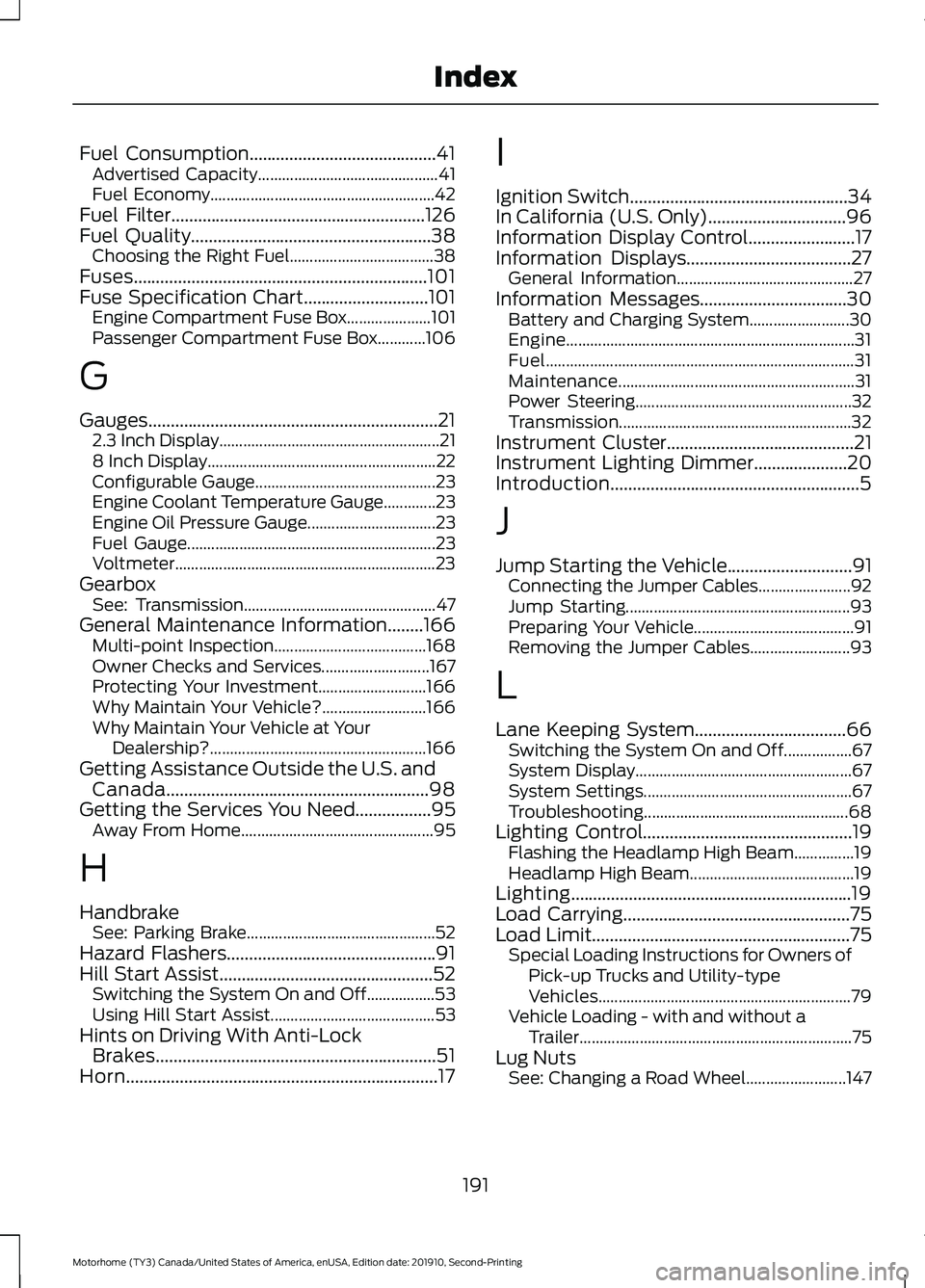
Fuel Consumption..........................................41
Advertised Capacity............................................. 41
Fuel Economy........................................................ 42
Fuel Filter.........................................................126
Fuel Quality......................................................38 Choosing the Right Fuel.................................... 38
Fuses..................................................................101
Fuse Specification Chart............................101 Engine Compartment Fuse Box..................... 101
Passenger Compartment Fuse Box............106
G
Gauges.................................................................21 2.3 Inch Display....................................................... 21
8 Inch Display......................................................... 22
Configurable Gauge............................................. 23
Engine Coolant Temperature Gauge.............23
Engine Oil Pressure Gauge................................ 23
Fuel Gauge.............................................................. 23
Voltmeter................................................................. 23
Gearbox See: Transmission................................................ 47
General Maintenance Information........166 Multi-point Inspection...................................... 168
Owner Checks and Services........................... 167
Protecting Your Investment........................... 166
Why Maintain Your Vehicle?.......................... 166
Why Maintain Your Vehicle at Your Dealership? ...................................................... 166
Getting Assistance Outside the U.S. and Canada...........................................................98
Getting the Services You Need.................95 Away From Home................................................ 95
H
Handbrake See: Parking Brake............................................... 52
Hazard Flashers...............................................91
Hill Start Assist
................................................52
Switching the System On and Off.................53
Using Hill Start Assist......................................... 53
Hints on Driving With Anti-Lock Brakes
...............................................................51
Horn......................................................................17 I
Ignition Switch.................................................34
In California (U.S. Only)...............................96
Information Display Control........................17
Information Displays
.....................................27
General Information............................................ 27
Information Messages
.................................30
Battery and Charging System......................... 30
Engine........................................................................\
31
Fuel........................................................................\
..... 31
Maintenance........................................................... 31
Power Steering...................................................... 32
Transmission.......................................................... 32
Instrument Cluster..........................................21
Instrument Lighting Dimmer.....................20
Introduction........................................................5
J
Jump Starting the Vehicle............................91 Connecting the Jumper Cables....................... 92
Jump Starting........................................................ 93
Preparing Your Vehicle........................................ 91
Removing the Jumper Cables......................... 93
L
Lane Keeping System..................................66 Switching the System On and Off.................67
System Display...................................................... 67
System Settings.................................................... 67
Troubleshooting................................................... 68
Lighting Control...............................................19 Flashing the Headlamp High Beam...............19
Headlamp High Beam......................................... 19
Lighting...............................................................19
Load Carrying
...................................................75
Load Limit..........................................................75
Special Loading Instructions for Owners of
Pick-up Trucks and Utility-type
Vehicles............................................................... 79
Vehicle Loading - with and without a Trailer.................................................................... 75
Lug Nuts See: Changing a Road Wheel......................... 147
191
Motorhome (TY3) Canada/United States of America, enUSA, Edition date: 201910, Second-Printing Index